
Maywood is a village in Proviso Township, Cook County, Illinois, United States in the Chicago metropolitan area. It was founded on April 6, 1869, and organized October 22, 1881. The population was 23,512 at the 2020 United States Census.

The George H. Miller House is a historic house located at 405 W. Market St. in Bloomington, Illinois. Prominent local architect George H. Miller built the house in 1890 for himself and his family. Miller designed many new buildings in downtown Bloomington after a 1900 fire destroyed much of the area; he also served as Superintendent of U.S. Buildings and designed many federal buildings in the Midwest. Miller's house is an eclectic variation on the Queen Anne design. The house features a hexagonal tower on its southeast corner and a conical dormer projecting from the front of the multi-component roof. The front entrance is arched and flanked by columns; small recessed porches are located above the entrance and on the east side of the house. The house has several stained glass windows, including a window with Miller's name at the front entrance and a large circular window on the west side.
Nichols House may refer to:

The Walter H. Gale House, located in the Chicago suburb of Oak Park, Illinois, was designed by Frank Lloyd Wright and constructed in 1893. The house was commissioned by Walter H. Gale of a prominent Oak Park family and is the first home Wright designed after leaving the firm of Adler & Sullivan. The Gale House was listed on the U.S. National Register of Historic Places on August 17, 1973.

The Thomas H. Gale House, or simply Thomas Gale House, is a house located in the Chicago suburb of Oak Park, Illinois, United States. The house was designed by famous American architect Frank Lloyd Wright in 1892 and is an example of his early work. The house was designed by Wright independently while he was still employed in the architecture firm of Adler & Sullivan, run by engineer Dankmar Adler and architect, Louis Sullivan; taking outside commissions was something that Sullivan forbade. The house is significant because of what it shows about Wright's early development period. The Parker House is listed as contributing property to a U.S. federally Registered Historic District. The house was designated an Oak Park Landmark in 2002.

The West Jackson Boulevard District in Chicago, Illinois, also known as West Jackson Historic District, was listed on the National Register of Historic Places in 1978. It was earlier designed as a Chicago Landmark, in 1976, and expanded as Jackson Boulevard District and Extension in 1997. The NRHP district was expanded in 1989 to include one more building, the James H. Pearson House.

The William H. Roberts House is a late 19th-century house located in Pecatonica, Illinois, United States. The house was built in 1883 for Dr. William H. Roberts, who died three years later at the age of 33. The building features a combination of elements from three distinct architectural styles, Italianate, Queen Anne and Gothic revival. The building functioned as both Roberts's house and office. The house is the only building in Pecatonica listed on the United States National Register of Historic Places, a status it attained in 1979.
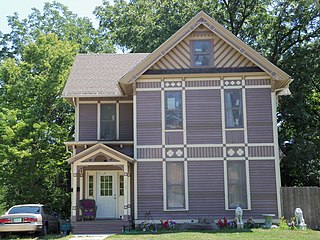
The Oscar Nichols House is a historic building located on the east side of Davenport, Iowa, United States. The house was built in 1884 by Oscar P. Nichols, who was a partner in the Davenport Nursery. The house is an example of Stick-Eastlake style of architecture. It is a version of the Queen Anne style where the wooden strips were applied to the exterior of the structure in vertical, horizontal. and on the diagonal to give it a basket-like quality. Other decorative elements applied to exterior of this house include the decoratively carved front porch that features an openwork tympanum at its gable end, the diagonal stickwork in the front gable end, a belt course of vertical strips between the first and second floor and molded vergeboards. It has been listed on the National Register of Historic Places since 1983.

The John L. Nichols House is a historic former residence in Bloomington, Indiana, United States. Built in a late variety of the Victorian style of architecture, it was constructed in 1900. Once the home of Bloomington's leading architect, it is no longer a residence, but it has been designated a historic site.
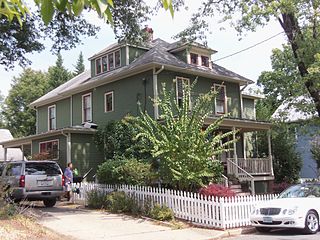
The Maywood Historic District is a national historic district located in Arlington County, Virginia. It contains 198 contributing buildings in a residential neighborhood located in the northern part of the county. The area was platted and subdivided in five sections between 1909 and 1913 following the arrival in 1906 of the Great Falls and Old Dominion Railroad. The area was primarily developed between 1909 and 1929. The dwelling styles include a variety of architectural styles, including Queen Anne, Colonial Revival foursquares, Bungalow, and two-story gable-front houses. Several dwellings in the neighborhood have been identified as prefabricated mail-order houses.

The Henry H. Page House is a historic house located at 221 North Union Street in Vermont, Illinois. Horse breeder Henry H. Page had the house built for his family in 1912–13. The house's design reflects a contemporary trend which architectural historian Alan Gowans described as Picturesque Eclectic; while its form distinctly fits a recognizable style, in its case the American Foursquare, its ornamentation borrows from multiple different styles. The large front gable dormer, which includes a horseshoe arch opening and decorated spandrels, is a Queen Anne feature. The cornice features both bracketing and stickwork, decorative elements of the Italianate and Stick styles respectively. The brick piers supporting the front porch come from the American Craftsman style, while the leaded windows are Classical Revival elements.

The Charles N. Loucks House is a historic house at 3926 N. Keeler Avenue in the Irving Park neighborhood of Chicago, Illinois. The house was built in 1889 for Charles N. Loucks, a real estate planner who developed much of Irving Park, and his family. Clarence H. Tabor, an architect who worked for Loucks' real estate company, designed the Queen Anne house. The house's design features a front porch with carved wooden trim and a pediment, a front-facing gable with a floral design at its peak, and a tower with a conical roof. The interior includes distinctive floral-patterned art glass windows, which include both clear and stained glass and were inspired by English and Japanese design.
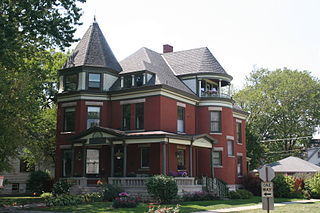
The Jacob Bohlander House is a historic house at 316 N. 4th Avenue in Maywood, Illinois. Jacob Bohlander, a local merchant who was Maywood's village president at the time, built the house circa 1894. The Bohlander family were among the earliest settlers of Proviso Township, and Jacob and his siblings all held positions in local government or led local businesses. The house was designed in a subtype of Queen Anne architecture known as free classical, which incorporated Neoclassical elements into the style. It includes a hexagonal tower, a rounded turret, a wraparound front porch, and multiple dormers.

The Mrs. Henry F. Akin House is a historic house at 901 S. 8th Avenue in Maywood, Illinois. The house was built circa 1910 for Elizabeth R. Akin, the wife of former Maywood mayor Henry F. Akin. Tallmadge and Watson, Chicago-area architects who were pioneers of the Prairie School style, designed the home. The one-story bungalow features a stucco exterior, wood banding which forms geometric shapes, casement windows, and overhanging eaves, all typical elements of early Prairie works. The house is one of three in Maywood designed by prominent Prairie School architects and the only bungalow of the three.

The Timothy J. Lynch House is a historic house at 416 N. 4th Avenue in Maywood, Illinois. The house, a large Chicago bungalow, was built in 1927. While thousands of bungalows were built in the Chicago area in the 1920s, including many others in Maywood, the Lynch House is unusual both for its size and its level of ornamentation. The house's design includes a main entrance with arched sidelights, round arched windows in a large front bay, patterned stained glass panels, and a green tile roof. Like many Chicago bungalows, the design features several elements of Prairie School architecture, such as the geometric designs in its stained glass windows, overhanging eaves, and wood trim on every door and window.
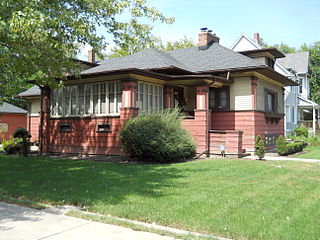
The Mads C. Larson House is a historic house at 318 S. 1st Avenue in Maywood, Illinois. The house was built in 1909 by Mads C. Larson on land previously owned by the Maywood Company, the development company which planned the village. The Arts and Crafts-designed bungalow also includes many elements of the Prairie School style. Its design has an emphasis on geometry and nature, featuring rectangular piers and pilasters with decorative banding, board-and-batten siding, a row of leaded casement windows, and a glazed sun porch. The interior continues the themes of the design with posts matching the exterior piers, wooden moldings, mullions with the same pattern as the leaded windows, and built-in cabinets.

The Joseph P. O. Sullivan House is a historic house at 142 S. 17th Avenue in Maywood, Illinois. The house was built circa 1895 by the Proviso Land Association for Joseph P. O. Sullivan. The Proviso Land Association was the second land developer to invest in Maywood, after the Maywood Company; most homes built by the Association have been demolished, making the Sullivan House a rare example of their work. Like many of the Association's homes, the Sullivan House has an American Foursquare design. The house has a rectangular two-story layout with a front porch, a projecting bay on one side, a hip roof, and a dormer with a classical Palladian window.

The William Frangenheim House is a historic house at 410 N. 3rd Avenue in Maywood, Illinois. The house was built in 1906 on a plot previously owned by the Maywood Company, the development company that planned Maywood. It is designed in the American Foursquare style, a vernacular style which was used in many Maywood houses of the period. Like most Foursquare homes, the house has a square two-story layout with a front porch and a hip roof with a dormer. In keeping with its utilitarian style, the house has little external decoration; its interior features Craftsman-inspired wood trim, though it is still relatively plain.
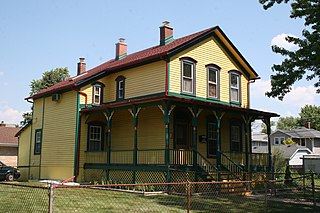
The Jennie S. Thompkins House is a historic house at 503 N. 4th Avenue in Maywood, Illinois. The house was built circa 1872 for Jennie S. Thompkins and her husband; they purchased its plot from the Maywood Company, the original developers of Maywood. It has a gable front design, a vernacular style commonly found in working-class Chicago homes of the period. While the gable front style was also common in Maywood, the house is an especially well-preserved example of the style, as most others have since been modified or sided. The design includes a three-bay facade with segmental arched windows and a wraparound front porch that features brackets, turned posts, and a balustrade.

The William H. Hatch House is a historic house at 309 Keystone Avenue in River Forest, Illinois. Grain trader William H. Hatch built the house for his family in 1882, early in the village's development and two years after its incorporation. The house has a Queen Anne style design, a popular choice both locally and nationally at the time. The design includes three spindlework porches, a tower at the southeast corner, and a shingled gable atop the front and rear facades. The emphasis on spindlework, while common in early Queen Anne designs, is unusual among examples of the style in River Forest.






















